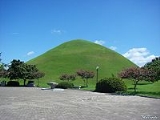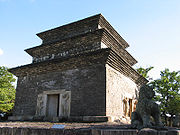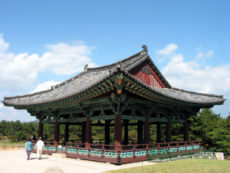
Gyeongju Historic Areas
Encyclopedia
The Gyeongju Historic Areas of South Korea
were designated as a World Heritage Site by UNESCO
in 2000 CE. The protected areas encompass the ruins of temples and palaces, outdoor pagodas and statuary, and other cultural artifacts left by the Silla
Kingdom. The historic areas are sometimes known as one of the largest outdoor museums in the world.
 The Mount Namsan
The Mount Namsan
belt is anchored by Mount Namsan, a mountain that was held sacred by the Silla people. Both Buddhist artifacts and artifacts related to Shamanism
that predate the introduction of Buddhism to Korea have been found at this site. Buddhist artifacts include the ruins of 122 temples, 53 stone statues, 64 stone pagodas, and sixteen stone lanterns. Other notable sites include the Namsan Mountain Fortress (built in 591
CE), the Poseokjeong
Pavilion site (famous for its abalone-shaped watercourse), and the Seochulji Pond. Mount Namsan is famous for the various Buddhist images carved into the rocks and also show the progression and maturation of Silla sculpture during the Unified Silla
period. The most famous example of these reliefs is the Buddha Rock. This bas-relief is located in the Tapgol Valley and consists of three walls decorated with the images of Buddha and his disciples. Tumuli of the Silla kings dating from the second century until the tenth century are also found at this belt.
(Half-moon Palace/Fortress), the Gyerim
forest, the ruins and reconstructions of the pavilions at the artificial Anapji
Pond, the ruins of the Imhaejeon Palace, and the famous Cheomseongdae
Observatory.
 This belt consists of three groups of royal tombs. Most of the tumuli are shaped like domes or mounds of earth. However, some are shaped like gourds or half-moons. Excavated tombs reveal wooden coffins covered with gravel and rich grave goods of gold, glass, and quality ceramics. A famous example of a tomb in this park is the Heavenly Horse Tomb
This belt consists of three groups of royal tombs. Most of the tumuli are shaped like domes or mounds of earth. However, some are shaped like gourds or half-moons. Excavated tombs reveal wooden coffins covered with gravel and rich grave goods of gold, glass, and quality ceramics. A famous example of a tomb in this park is the Heavenly Horse Tomb
which contained a mural painting on birch bark saddle flap of a winged horse.
Temple and Bunhwangsa
Temple. According to the excavated foundation stones, Hwangnyongsa was the largest temple ever built in Korea and covered 72,500㎡. The Bunhwagsa Temple exists today at a fraction of its size. In the past, it was one of the most important Buddhist temples. A stone pagoda made from brick-like stones is a popular ruin. It is believed to have had seven or nine stories but only three remain today.
South Korea
The Republic of Korea , , is a sovereign state in East Asia, located on the southern portion of the Korean Peninsula. It is neighbored by the People's Republic of China to the west, Japan to the east, North Korea to the north, and the East China Sea and Republic of China to the south...
were designated as a World Heritage Site by UNESCO
UNESCO
The United Nations Educational, Scientific and Cultural Organization is a specialized agency of the United Nations...
in 2000 CE. The protected areas encompass the ruins of temples and palaces, outdoor pagodas and statuary, and other cultural artifacts left by the Silla
Silla
Silla was one of the Three Kingdoms of Korea, and one of the longest sustained dynasties in...
Kingdom. The historic areas are sometimes known as one of the largest outdoor museums in the world.
Mount Namsan Belt

Namsan (Gyeongju)
Namsan is a 494-meter peak in the heart of Gyeongju National Park, just south of Gyeongju, South Korea. The mountain is within easy reach from the city and attracts a large number of national tourists. Namsan covers an area of about 8 km by 12 km...
belt is anchored by Mount Namsan, a mountain that was held sacred by the Silla people. Both Buddhist artifacts and artifacts related to Shamanism
Korean shamanism
Korean shamanism, today known as Muism or sometimes Sinism , encompasses a variety of indigenous religious beliefs and practices of the Korean people and the Korean area...
that predate the introduction of Buddhism to Korea have been found at this site. Buddhist artifacts include the ruins of 122 temples, 53 stone statues, 64 stone pagodas, and sixteen stone lanterns. Other notable sites include the Namsan Mountain Fortress (built in 591
591
Year 591 was a common year starting on Monday of the Julian calendar. The denomination 591 for this year has been used since the early medieval period, when the Anno Domini calendar era became the prevalent method in Europe for naming years.- Europe :* Agilulf marries Theodelinda and becomes king...
CE), the Poseokjeong
Poseokjeong
The Poseokjeong site near Namsan in Gyeongju, Gyeongsangbuk-do South Korea, was built in the Silla period. The site once featured a royal pavilion–said to have been the most beautiful royal villa of the time—, but the only remains today is a granite water feature. This abalone-shaped watercourse...
Pavilion site (famous for its abalone-shaped watercourse), and the Seochulji Pond. Mount Namsan is famous for the various Buddhist images carved into the rocks and also show the progression and maturation of Silla sculpture during the Unified Silla
Unified Silla
Unified Silla or Later Silla is the name often applied to the Korean kingdom of Silla, one of the Three Kingdoms of Korea, when it conquered Baekje in 660 and Goguryeo in 668, unifying the southern portion of the Korean peninsula...
period. The most famous example of these reliefs is the Buddha Rock. This bas-relief is located in the Tapgol Valley and consists of three walls decorated with the images of Buddha and his disciples. Tumuli of the Silla kings dating from the second century until the tenth century are also found at this belt.
The Wolseong Belt
The main attractions of this portion of the Gyeongju Historic Areas are the ruins of BanwolseongBanwolseong
Banwolseong , also commonly known as Wolseong Palace, was the royal palace compound of the Korean Silla monarchy at their capital in Gyeongju during the Silla and Unified Silla periods . It takes its name from the approximate outline of the palace walls which were shaped like a crescent moon...
(Half-moon Palace/Fortress), the Gyerim
Gyerim
The Gyerim is a small woodland in Gyeongju National Park, Gyeongju, South Korea. The name literally means "rooster forest." The grove lies near the old site of the Silla kingdom palace in central Gyeongju. Nearby landmarks include the Banwolseong fortress, Cheomseongdae, the Gyeongju National...
forest, the ruins and reconstructions of the pavilions at the artificial Anapji
Anapji
Anapji, or Anap Pond is an artificial pond in Gyeongju National Park, South Korea. It was part of the palace complex of ancient Silla . It was constructed by order of King Munmu in 674 CE. The pond is situated at the northeast edge of the Banwolseong palace site, in central Gyeongju. It is an...
Pond, the ruins of the Imhaejeon Palace, and the famous Cheomseongdae
Cheomseongdae
Cheomseongdae is an astronomical observatory in Gyeongju, South Korea. Cheomseongdae means star-gazing tower in Korean. Cheomseongdae is the oldest surviving observatory in East Asia, and one of the oldest scientific installations on Earth. It dates to the 7th century to the time of kingdom of...
Observatory.
The Tumuli Park Belt

Heavenly Horse Tomb
Cheonmachong, formerly Tomb No.155, is a tumulus located in Gyeongju, South Korea. The tomb was excavated in 1973 and is believed to date probably from the fifth century but perhaps from the sixth century CE...
which contained a mural painting on birch bark saddle flap of a winged horse.
Hwangnyongsa
This cluster of historic remains is centered around the ruins of HwangnyongsaHwangnyongsa
Hwangnyongsa, or Hwangnyong Temple, is the name of a former Buddhist temple in the city of Gyeongju, South Korea. Built in the 6th century, it was the center of state-sponsored Buddhism during the Silla and Unified Silla eras...
Temple and Bunhwangsa
Bunhwangsa
Bunhwangsa is a temple complex from the Old Silla era of Korea. It is located in Gyeongju. The temple is recorded to have been built in 634 under the auspices of Queen Seondeok...
Temple. According to the excavated foundation stones, Hwangnyongsa was the largest temple ever built in Korea and covered 72,500㎡. The Bunhwagsa Temple exists today at a fraction of its size. In the past, it was one of the most important Buddhist temples. A stone pagoda made from brick-like stones is a popular ruin. It is believed to have had seven or nine stories but only three remain today.

